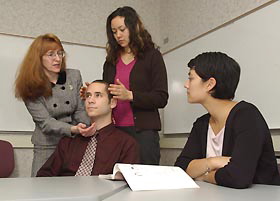|
This is an archived article.
For the latest news, go to the Advance
Homepage
For more archives, go to the Advance Archive/Search Page. | ||
|
Group
Formed at Medical School
to Explore Alternative Treatments
The reality deserved inspection:
At the Health Center, interested students and faculty can now explore this field through the Integrative/Complementary and Alternative Medicine interest group.
Mary P. Guerrera, an associate professor of family medicine, is the I/CAM faculty advisor. She says the idea of the group is to improve understanding to better serve patients and the community. "Our group's mission is to provide a forum for students, faculty and other members of the university to evaluate, discuss and experience those modalities of health care that are currently considered unconventional," she says. "That forum will allow interested persons to engage in scholarly inquiry into this evolving field." Inquiry is the key. In 1998, Congress established the National Center for Complementary and Alternative Medicine at the National Institutes of Health to look into complementary medicines. The center's mission is to provide reliable information through research about the safety and effectiveness of complementary or alternative medicine practices. Similarly, the Health Center's I/CAM interest group is involved in scientific questioning.
The group has met several times and is developing cordial relations with the Connecticut Holistic Health Association, whose members include practitioners of acupressure, chiropractic, craniosacral therapy, guided imagery, hypnotherapy, massage therapy, reiki, and psychotherapy. Erin Kong, a fourth-year medical student; Elizabeth Dziadik, a second-year medical student; and Erin Wysong, a third-year medical student, are the I/CAM Interest Group's student leaders. Wysong, the daughter of an Episcopal priest, says she has long been interested in the spiritual side of medicine. That interest was further honed when she took an alternative medicine elective that looked at a variety of complementary therapies. "It was fascinating," she says. "Western medicine is wonderful - it's why I chose to be a medical doctor - but I'm interested in cancer and hematology-oncology and you see patients suffer. If mind-body therapeutics or spirituality can ease that suffering, then I'm all for it." The juncture of where "complementary" and "alternative" meets "medicine" hasn't always been convivial. And often patients get caught in between. The National Center for Complementary and Alternative Medicine reports people use complementary or alternative approaches not only because they are dissatisfied with conventional medicine, but because these health care alternatives mirror their own values, beliefs, and philosophies about health and life. Guerrera says many patients use complementary or alternative medicine but do not inform their medical doctor. This can be dangerous, she says, because gaps in communication may lead to adverse events. It also erodes the doctor-patient relationship. One way to overcome this is for medical doctors as well as other health professionals to better understand complementary and alternative medicine. "Medical schools are just beginning to integrate such topics into required curricula," she says. "Many students, faculty, researchers and members of the community are voicing the need for more information and training in this area. Our interest group is a step towards that understanding." For more information, e-mail Dr. Guerrera at mguerrer2@stfranciscare.org. Pat Keefe |
 n the dusk of the 20th century, the government decided to
take a scientific look at "alternative medicines,"
treatments for illness or maintaining health such as herbal
medicine, massage, megavitamins, folk remedies, energy healing,
naturopathy and homeopathy, variously used or practiced by millions
of people in the United States and billions worldwide.
n the dusk of the 20th century, the government decided to
take a scientific look at "alternative medicines,"
treatments for illness or maintaining health such as herbal
medicine, massage, megavitamins, folk remedies, energy healing,
naturopathy and homeopathy, variously used or practiced by millions
of people in the United States and billions worldwide.
